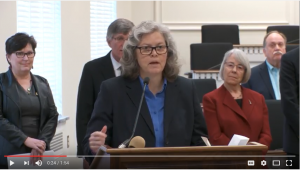Hello friends and neighbors,
I got home at 1:00 a.m. this morning after voting a budget I’m very proud of out the House Appropriations committee. As you may know, this week, House Democrats released their budget proposal for the upcoming two-year state budget cycle. We listened to the concerns of people across the state, who asked us how we can improve education, make college affordable, create thriving communities and increase access to quality health care. This budget does all of these things.
This is a “Families First” budget because in addition to meeting our paramount duty to fully fund K-12 education, we also make key investments in early learning, higher education, critical human services, housing, mental health, and public health, among others. It represents a contract between generations, and we know it’s very difficult for kids to succeed in school if they are also dealing with domestic violence or mental illness in the home, or if they are homeless or hungry.
I’ve included more specific information about the investments our budget makes, how our proposal differs from the Senate Republican budget proposal, and how we pay for the investments we make.
As always, please don’t hesitate to contact my office if you have questions or concerns about the budget proposal or any legislative issue.
Sincerely,

A “Families First” budget
The centerpiece of the House Democrats budget is the $7.1 billion in additional investments for K-12 education. This funding addresses four top priorities:
• Fully funding our K-12 public schools
• Closing the opportunity gap
• Placing high quality teachers in every classroom
• Preparing every student for success after high school
Here’s what we invest in:
• Addressing the teacher shortage by raising salaries for beginning teachers, providing fair compensation to all teachers, investing in ongoing professional development, and including teacher COLAs as part of basic education.
• Additional guidance counselors to better prepare students for college or careers beyond high school.
• Parent engagement coordinators to ensure families are directly involved in student success.
• Proven programs that help close the opportunity gap for struggling students, and programs that serve highly-capable students.
Additional highlights of the budget proposal include:
• Freezing college tuition and increasing investments in state-funded financial aid, to help families pay for college.
• Expansion of quality early learning programs and childcare resources for working families.
• Investments in our mental health system to ensure everyone gets the treatment they need in the proper setting.
• Health care investments to preserve critical funding and services and tackle the opioid crisis that is hurting families and communities.
 At our budget rollout press conference on Monday, I spoke about the investments in our mental health care system, which add up to $350 million over the next four years. Click the image on the left to hear my brief remarks about why the nationwide shortage of mental health providers is especially dire here in Washington state, and how our budget addresses that shortage.
At our budget rollout press conference on Monday, I spoke about the investments in our mental health care system, which add up to $350 million over the next four years. Click the image on the left to hear my brief remarks about why the nationwide shortage of mental health providers is especially dire here in Washington state, and how our budget addresses that shortage.
Our budget stands in stark contrast to the Senate Republican budget. We have chosen to invest in programs that address homelessness, programs that help struggling families stay on their feet, and quality care for aging Washingtonians and people with developmental disabilities.
The Senate Republican budget, on the other hand:
• Slashes housing services for homeless youth and families
• Rolls back progress to improve the quality of childcare
• Raises college tuition and ignores the growing backlog of those seeking state grants to be able to afford college
• Rejects over $1 billion in federal Medicaid funding
Those choices would take our state in the wrong direction, and harm the most vulnerable in our communities.
Our revenue proposal

Both the House and Senate have acknowledged that Washington doesn’t currently generate enough revenue to create an exceptional education system without cutting some or all of the critical state services mentioned above. Even our Republican colleagues agree that more money is needed, and in addition to deep cuts to state services, they proposed a $5.5 billion property tax to fund their budget.
Our progressive revenue plan cuts taxes for families and businesses, while improving the fairness of our tax system to make these needed investments. Washington has the nation’s most regressive tax system (see graph above), something my seatmates and I addressed at our recent town hall meeting. You can read more about the House Democrats revenue package here and here, but the highlights are:
• It reforms our state’s Real Estate Excise Tax to a progressive rate.
• It ends the corporate tax break on capital gains, which would affect less than 2 percent of Washington tax filers, and exempt retirement accounts and sales of single family homes.
• It levels the playing field with out-of-state online retailers, who are not currently collecting and remiting sales tax.
• It reduces tax liability for small businesses by reforming the B&O tax.
• It closes tax breaks that don’t measure up against our kids’ education needs.
Now that both chambers have introduced budget and revenue plans, both sides will start negotiating a compromise solution to send to the Governor. I remain committed to a budget that puts families first, that fully funds our education system without cutting programs that serve our most vulnerable Washingtonians, and that makes our state’s tax system more fair instead of less fair.
